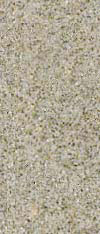 |

Astronomers
have found a wild bunch of planets outside our solar system. Now, scientists
are asking what these strange giants can tell us about how planets form.
On the isolated peak of Mt. Hamilton, 20 miles up a tortuous road from
San Jose, California, the white domes of Lick Observatory stake out the
sky. On most fair-weather nights, the observatory buildings house an astronomer
searching starlight for clues to other worlds.
At 4 p.m. on an early February day, 2001, the center slice of the largest
dome slides back. In the submarine-like spaces around the 3-meter reflector
telescope, Debra Fischer, a member of the world’s most successful
planet-hunting team, hurries to prep the equipment for a 12-hour observing
stint. She races beneath the massive yellow telescope, pausing briefly
to examine the exposed slice of now-violet sky. Light, high clouds—no
problem, the telescope can see right through them. Lithe and purposeful,
she darts through gray metal doors, down a narrow stairwell, around the
corner, farther underground, ducking under instrument arms as she pushes
and pulls equipment into place.
Blonde hair tucked behind her ears, Fischer pours liquid nitrogen into
the body of the light detector, cooling the key machine to operating temperature.
“This is why I became a scientist,” she says, smiling, “to
pour steaming, smoking stuff from one vial to another.”
At 6:15, she and the telescope operator begin a meticulous hunt. They
point the telescope at one star after another and take a digital photograph
of each, snapshots that will tell her whether or not each star is moving.
Though she examines the stars, she’s actually searching for planets.
The planets themselves are invisible, so Fischer must infer their presence
by checking for planets’ effect on their stars. A star without any
orbiting planets appears at rest, or randomly fidgeting. A star with planets,
however, moves to a beat; it waltzes with each planet. One photo reveals
a single sidestep or half turn. Fischer must compile a sequence of photographs,
taken over weeks, months, or even years, to be certain the star is circling
through an entire box step. Once she’s sure the star is waltzing,
Fischer looks to see how big an area its covering and how evenly. The
grace and breadth of the star-dance tells her something about the heft
and style of the star’s planetary partner. Finally, she and her colleagues
proclaim a new planet, called an extra-solar planet because it is in orbit
around a distant star rather than our own sun.
The first extra-solar planet, found in 1995, sparked a barrage of discoveries
that has shot holes in traditional explanations of how planets form. Before
1995, theorists were forced to make guesses at the processes that shape
planets based solely on evidence from our own solar system, with no idea
whether our system is rare or common. Extra-solar planets offer a wealth
of new data, revealing the results of some of the universe’s other
planet-making experiments. Those results hint at a laboratory far different
than most scientists imagined. The credos of planet making have fallen
by the wayside while proposals that once seemed flagrant speculation are
winning the race.
Planet-hunters have discovered a troupe of behemoths that travel wilder
paths and dwell far closer to their stars than anyone thought possible.
Old-hat theories of planet formation maintained that planets Jupiter’s
size form farther from their star, leaving smaller Earth-like planets
to reside peacefully in the warm embrace of the Sun. But from the get
go planet-hunters found gas giants circling just a hairs breadth from
their star’s scalding surface. Sticking to the logic of our solar
system, theorists declared that planets could grow no larger than Jupiter.
Among extra-solar planets, however, planets two, three, even four times
Jupiter’s mass are not obese. And many of the big guys wend long
squashed orbits, though theorists once thought the nature of a planet
required it to travel a circular orbit.
Trying to figure out how planets form is like reading a mystery novel,
said Douglas Lin, an astrophysicist at the University of California, Santa
Cruz. “If you read Agatha Christie for the first time, very often
you jump to conclusions based on a limited number of facts. That is sort
of the way we are attacking nature.” Lin smiles. “Nature is
much more imaginative than we are.”
Lin was one of the few theorists to challenge prevailing theories before
astronomers found any extra-solar planets. Now, there are enough clues
to give astronomers a better idea of what lurks around some five percent
of stars—and it appears that the clues bear out many of Lin’s
seemingly preposterous ideas.
The discovered extra-solar planets have jumpstarted the imaginations of
theorists everywhere. “It’s the golden age of theorists. They
can let their theories be fruitful and multiply,” said Alan Boss
of the Carnegie Institution in Washington, DC. Boss is another astrophysical
pioneer, holding a few theories of his own to explain the wilder residents
of our universe.
While
theorists struggle to explain the strange qualities of extra-solar planets,
planet hunters like Fischer are searching for more. It’s easiest
to spot planets in small orbits; the closer a planet is to a star, the
harder it’s gravity yanks. Planet-hunters are limited to what they
can tell from changes in starlight, so the bigger the motion the better.
To see the star’s movement, Fischer takes advantage of a phenomenon
called Doppler shift—the same reason the siren of an approaching
fire-truck drops in pitch once it speeds past you. The phenomenon works
for both light and sound because both travel in waves. Since a star, like
the fire truck’s speaker, is the source of the waves, its motion
changes how the light appears to us, as distant observers. Visible light
is made up of a rainbow of composite colors. Each color is represents
a different wavelength. When the star waltzes toward Earth, it compresses
the wavelengths of its light, just as the approaching fire truck compresses
the wavelengths of the siren. The shortened wavelengths make the siren
sound higher in pitch, but they lend the starlight a blue cast, because
blue light is at the shorter end of the wavelength scale. If the star
moves away from us, it stretches the wavelengths of the light it shines.
For the receding fire truck, stretched wavelengths sound like a lower
pitch. For a star, we see a reddish hue because red light has longer wavelengths.
The faster the fire truck or star travels toward or away from us, the
more dramatic the shift. A star moving sideways relative to the Earth,
however, won’t shift in color because it doesn’t compress or
stretch the wavelengths of its light. Since the shift in wavelength is
our only proof that a star is moving, we can only detect the star’s
motion toward and away from Earth, even though a star with an orbiting
planet is moving in a circle.
click
to see flash animation (89 Kb)
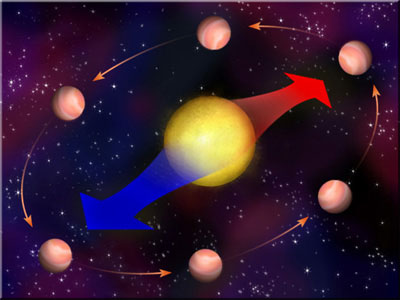
Regular
shifts between blue and red light suggest that an orbiting planet is tugging
on the star.
Fischer
can, however, tell that the star is moving in a circle because its speed
toward or away from us changes as it travels the circle. When Fischer
maps the star’s color shifts over time, she gleans a plot of the
star’s changing speed. If the plot undulates like a sine wave, a
line that curves up and down as the star moves toward us and then away,
she knows she’s found a planet. No other phenomenon could create
such a regular pattern, astronomers believe.
If a planet is too small or travels too large an orbit, its pull is imperceptible.
Current instruments are sensitive enough to detect Saturn-mass planets,
but only if they are in Mercury-size orbits. Plus, to determine the size
of the planet and its orbit, observers must watch an entire rotation.
If we were looking at the Sun from space, we wouldn’t have seen Jupiter
yet, Fischer said. That would take 12 years, but we’ve only been
looking for about eight.
The time restriction explains why researchers are only beginning to identify
systems of several planets orbiting the same star. Her team has found
“four completely-done, fully-cooked multiple systems,” Fischer
said. There are many others where they see the beginnings of a pattern,
but haven’t watched long enough to see each planet’s full orbit.
“The systems we’re finding appear to be quite full,” she
said. “If you want to find another planet, look where there’s
already one.”
The first planet found orbiting a distant star is an exception: it lives
alone. This planet also shot down the theory that large gaseous planets
form far from a star and never venture into its warm inner circle. This
planet, named 51 Pegasi B, is a giant the mass of Jupiter. Living in entirely
different habitat, 51 Peg skims the surface of its star, traveling once
around in just four days compared to Jupiter’s leisurely 12 years.
Jupiter’s home was long thought prime real estate for the making
of giant planets. In the planetary nursery— vast spinning disks of
gas and dust that swathe young stars—the most raw material sits halfway
between the star and the outer edge of the disk. That’s partly because
the climate there is cool enough for ice to form, tripling the planet-making
ingredients. Astronomers are still relatively certain that big planets
cannot form in the veritable inferno of a star’s immediate surroundings.
With the discovery of 51 Peg, though, they are pressed to explain how
a planet might get there.
Before 51 Peg’s discovery, Lin and others argued that a gas giant
might form at a distance and then spiral slowly toward its star. But this
theory of migration was only a worry to a “handful of theorists”
who thought that if a planet did migrate, it would keep on going, eventually
getting engulfed by its star, said Alan Boss. The worry originated in
the 1970s when researchers from the California Institute of Technology
observed the rings of Saturn dragging on inner moons, slowing them down
and causing them to spiral toward Saturn. They proposed that the disk
might do the same to young planets. For Lin, who expanded the theory,
the idea that disks drag planets became a sort of battle cry, proclaimed
at a 1993 meeting in Hawaii.
“Everybody was getting up and saying, ‘There are no planets,
there are no planets, there are no planets out there. It’s very difficult
to form planets and we’re unique, unique, unique.’ So I said,
‘Maybe we’re not so unique. It’s just that [planets] form.
They move. Then they move inside the star—they get gobbled up,”
Lin said.
As planets grow, Lin says, they sweep up the gas and dust in their path,
clearing a gap that splits the disk into two regions. The inner dust and
gas dashes around its star, traveling a tighter circle. This shorter orbit
means that the inner disk has more of an energy currency, called “angular
momentum,” than the planet. The planet, in turn, has more angular
momentum than the outer ring. The greedy outer ring steals energy from
the planet. To recoup, the planet steals energy from the inner disk. But
as the inner disk loses energy, it sinks toward the star. The outer ring
continues to steal from the planet, but now the planet can’t reach
the inner disk. The planet, too, spirals slowly inward.
Click
to see Flash animation (381 Kb)
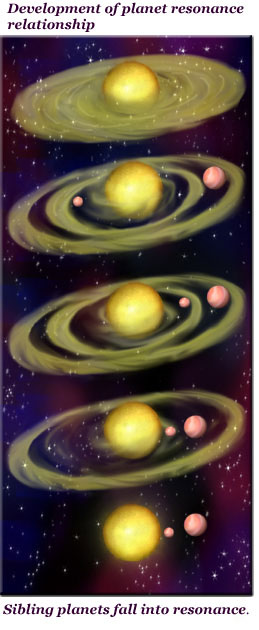 This
theory of migration is helpful, but it doesn’t explain why the gas
giant stopped short of certain annihilation. A few days after the discovery
was confirmed, Lin and his colleagues proposed two explanations. Perhaps
the star’s magnetic field swept away the dust and gas closest to
it, getting rid of the disk’s friction-tug. Once 51 Peg made it into
the open, it could safely circle in a drag-free orbit, they proposed.Or
maybe once the planet drifted close enough, it would excite tides in its
molten star, like the moon does to liquid on Earth, they proposed. The
star spins just faster than the planet orbits, so the tides would keep
just ahead of the planet. The extra gravitational pull from the bulges
would tug the planet forward, they said, fighting the disk’s drag,
and keeping the planet from sinking into the star. This
theory of migration is helpful, but it doesn’t explain why the gas
giant stopped short of certain annihilation. A few days after the discovery
was confirmed, Lin and his colleagues proposed two explanations. Perhaps
the star’s magnetic field swept away the dust and gas closest to
it, getting rid of the disk’s friction-tug. Once 51 Peg made it into
the open, it could safely circle in a drag-free orbit, they proposed.Or
maybe once the planet drifted close enough, it would excite tides in its
molten star, like the moon does to liquid on Earth, they proposed. The
star spins just faster than the planet orbits, so the tides would keep
just ahead of the planet. The extra gravitational pull from the bulges
would tug the planet forward, they said, fighting the disk’s drag,
and keeping the planet from sinking into the star.
The
disk-drag migration scenario was bolstered by the discovery of an unusually
harmonious two-planet system early this year. In the system, announced
by the leaders of Fischer’s team, Geoffrey Marcy at UC Berkeley and
Paul Butler of the Carnegie Institution, two planets circle a star 15
light-years away in the constellation Aquarius. The smaller planet, at
half Jupiter’s mass, circles the star twice as fast as the larger,
which is nearly twice Jupiter’s mass. Lin and his colleagues predicted
that planets of that size could exist in just such a partnership, called
resonance.
Lin’s
team thinks the two planets formed in more spacious orbits, farther from
their star and from each other. As the two grew up, they gobbled up new
material and picked their orbital paths clean. That process split the
disk into three parts, with a disk-ring between the planets. Like all
full-fledged planets, each created ripples in this middle disk ring as
they circled. If only one planet were present, the ripples would have
fizzled out like the waves of a pebble dropped into a pond. In between
the two planets, however, the waves crashed into each other, quickly scattering
the dust and gas. The middle ring disappeared.
The
middle ring now gone, the outer ring stole energy from the large planet,
pushing it in. The smaller, inner planet stole from the inner disk and
used its new energy to bound outward. Finally, the two came close enough
that the smaller planet circled exactly twice as fast as the larger planet.
In this configuration their gravity tugged at each other in the same spots
in each orbit, and this tugging locked them together. The inner planet
circled twice for every orbit of the outer planet. Once together, they
slowly migrated inward, like a single planet, to their current spots.
The new discovery sets Lin’s theory ahead of others. Some have suggested,
less successfully, that large planets might have formed close to their
stars, but it’s unlikely that these two planets could have formed
in resonance. Others suggest that certain forces could sling large planets
quickly in, but this also would disrupt any resonance.
Still, Lin hasn’t always been right. In the 1970’s, when his
current theories were just wild ideas, Lin argued that planets could grow
no bigger than Jupiter. Many astronomers agreed, but nature had a surprise
in store.
“Many of these objects are so darn massive,” said Carnegie Institution
astronomer Alan Boss. Astronomers have found some planets more than 5
times Jupiter’s mass. Two major theories have been proposed to explain
how these giants might form. The older theory suggests that bigger planets
could form just like their smaller cohorts, building up slowly as dust
and ice collides and sticks. The planet grows fatter as it plows through
the material in its orbital path, much as a snowball rolling down hill
picks up snow and ice. Once this core of matter gets large enough, its
gravity sucks in gas. This process, called core accretion, could take
more than a million years. By then the disk gas would have slipped from
the planet’s grasp and drifted into the star or out to space.
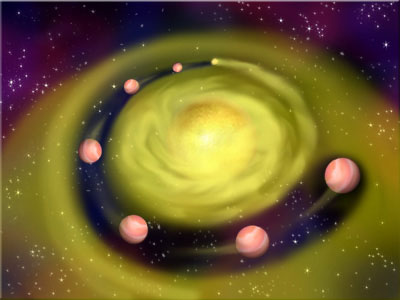
Particles
of ice and dust collide and stick together, slowly building up a planet.
Boss
thinks monster planets might form differently. The disk surrounding a
star can be clumpy, with the dust, ice and gas distributed unevenly. Boss
predicts that the gravity of a large enough clump would compress the matter
into a planet. The gravity acts much like a child’s hands taking
two handfuls of fluffy snowflakes and packing them into a dense snowball.
When gravity packs the dust and gas into a planet, a process called disk
instability, gas giants Jupiter’s mass or larger might form in less
than half the time predicted by the theory of core accretion.
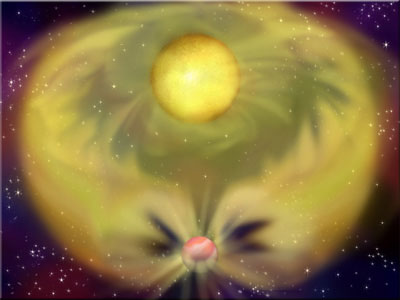
Gravity
quickly compresses a particularly dense clump of dust, ice and gas into
a planet.
It
may be that different sized gas giants form differently. It is difficult
to follow the rules of core accretion and come up with a planet even a
large as Jupiter, Boss said. On the other hand, predictions show that
disk instability best creates planets larger than Jupiter.
Boss predicted disk instability could spawn a system of lumbering giants
almost identical to another new system two-planet system announced early
this year by Marcy and Butler. The smaller of the two is a whopping seven
times Jupiter’s mass. It orbits its sun-like star at one-third the
Earth’s distance from the sun. The second and larger planet is between
17 and 40 times Jupiter’s mass, traveling at a distance that is three
times the space between the Earth and the sun.
Differences in birth may also explain why many gas giants travel in stretched-out
orbits. “We sort of looked in the back of the book to see what the
answers were. Saturn has a circular orbit. Jupiter has a circular orbit.
Planets must have circular orbits,” Boss said. Actually, of the discovered
planets, those farther than a stone’s throw from their star travel
orbits that are distortedly elliptical, coming very close to their star
and then shooting off into the distance before returning.
Theorists scratched their heads and wondered if something had forced the
planets out of a comfortable circular orbit, or if they were born eccentric.
Disk instability could give birth to planets in eccentric orbits, Boss
said. Core accretion would produce planets in circular orbits. A core-accreted
planet, however, could be pushed and pulled into eccentric orbit if it
were born in a system with other large planets, Lin says.
The difference between a one-planet system and a multiple-planet system
is “like having a one child family versus a three child family,”
Lin said. “The three perturb each other constantly.” After a
billion-year tug of war, the planets barrel around their star in erratic
orbits. If their orbits cross, they may collide to form a doubly massive
planet with a looping orbit. Otherwise, their orbits become progressively
wilder until one is shot into the sun or out to interstellar space, leaving
the remaining sibling to orbit in peace. If gas giants are such grumpy
bedfellows, there should be planets floating through space, free from
any star. Lin is certain astronomers will find free-floaters.
Maybe
they already have. Members of a research team in Tenerife, Spain, discovered
free-floating objects in the Orion Nebula. Their possible masses—5
to 15 times Jupiter’s—are low enough that the researchers called
them “isolated giant planets” in a paper published on October
6, 2000, in the journal Science. Most scientists think they are too large
to have been ejected—usually it’s the smaller, weaker planet
that gets kicked out.
The debate circles back to a question that has astronomers quarrelling:
what is a planet? Simple, you might say, a planet orbits a star. Unfortunately,
some very big things orbit stars, while planets might have been kicked
out. The largest objects might be failed stars called brown dwarfs, but
it’s tough to tell. Brown dwarfs form like a star—from a collapsing
cloud of dust and gas—but never grow massive enough to burn hydrogen.
Only when it hits 80 Jupiter masses is a star’s core hot enough,
and pressurized enough, to spark major nuclear fusion. Over 13 Jupiter
masses, though, a brown dwarf will burn a heavier form of hydrogen before
fading into oblivion. Since it’s impossible to look at an object
and tell how it formed, some astronomers argue that anything smaller than
13 Jupiter masses should be called a planet.
A division based purely on size might be convenient, Alan Boss said, but
it’s not entirely accurate. He has calculated the same core collapse
that gives birth to a star could create objects only a few times Jupiter’s
mass. So, he says, there are objects a good deal smaller than 13 Jupiter
masses that should probably be termed brown dwarfs.
Alan Boss heads a consortium of scientists that are trying to settle on
a definition. Personally, Boss said, contemplating definition of a planet
has often kept him up late. “I view a star as something that forms
through gravitational collapse,” Boss said. “Planets are the
epilogue, after the final act of star formation—leftovers that manage
to clump together and form a planet by any mechanism. That’s what
helps me sleep at night.”
Lin is not as interested in the debate. “Maybe the best way to refer
to these objects is not to give them a name, or not to worry so much about
a name—like calling so and so a Democrat or a Republican. It’s
almost irrelevant these days. Some Democrats sound awfully like Republicans
and some Republicans, well, may have certain shades of Democrat in them.
Perhaps it’s better just to ask what their properties are.”
He did agree with his UCSC colleague Peter Bodenheimer, who defined a
planet as something, below some maximum mass, that was borne from the
disk around a star. That doesn’t mean the planet is still circling.
They probably won’t settle the debate until astronomers can gaze
directly at planets and piece together a planetary life cycle by comparing
systems in all stages of planet formation.
Then, they’ll also detect earth-like planets. But do any rocky earth-like
planets hide in the neighborhoods we’ve discovered so far? Most of
the planets found so far are “gravitational bullies” that would
have either stopped an Earth-like planet from forming or would have kicked
it out long ago. Barrie Jones of The Open University in Great Britain
has pinpointed at least two planetary systems where a rocky planet might
have been able to form in the so-called habitable zone of its star—where
it is warm enough for water to exist as a liquid. The two planetary systems
have gas giants either well inside this habitable zone, or well outside
it. There’s a fifty-fifty chance that life might have found a fertile
foothold in either system, Jones believes.
Planetary systems like our own cozy solar system, with its circular orbits
and svelte planets, could crop up within the next ten years. Will the
planet hunters find a plethora, or are we one of a lucky few?
“It’s premature to say that we’re unique, or even odd,”
Lin said. So far astronomers have found large, close planets orbiting
five to eight percent of stars. “All we can really say is that the
frequency of solar systems could be somewhere between zero and 90 percent,”
Alan Boss said. “My guess is it’s somewhere toward the middle.”
Two NASA programs seem likely to help astronomers find solar systems like
our own. The first is the Space Interferometry Mission, scheduled to launch
in 2006. Outside the distorting effects of the Earth’s turbulent
atmosphere, a machine called an interferometer will manipulate light waves
to reveal a star’s motion, not just a color shift. The mission will
be able to see planets five Earth-masses around stars closer than 35 light-years,
and it will be able to find them around younger stars whose surfaces are
too tumultuous for current methods. Some astronomers think they can do
the same thing from the ground by canceling out atmospheric interference.
The grander Terrestrial Planet Finder is still on the drawing board. This
project will look specifically for Earth-like planets. It will use a larger
interferometer to dim the image of a star, allowing researchers to actually
see planetary systems. It is expected to take more than a decade to come
to fruition. Either way, theorists must wait to have their hypotheses
confirmed or discounted.
Theorists don’t seem frustrated, however. “I like to have a
little room to lead the observational effort a little bit—to make
some predictions that people can actually test rather than always following
what people already found,” Lin said. “You always feel enormously
rewarded when even the smallest amount of ‘prediction’ you make
is verified, because you thought of it before people revealed it.”
Boss is more expansive. “This is the most thrilling part of my life.
I’ve been working on this stuff since 1975. For years we had only
our Solar System, only one answer. Now we are in a phase where there are
new answers. It’s exhilarating.”

|





















